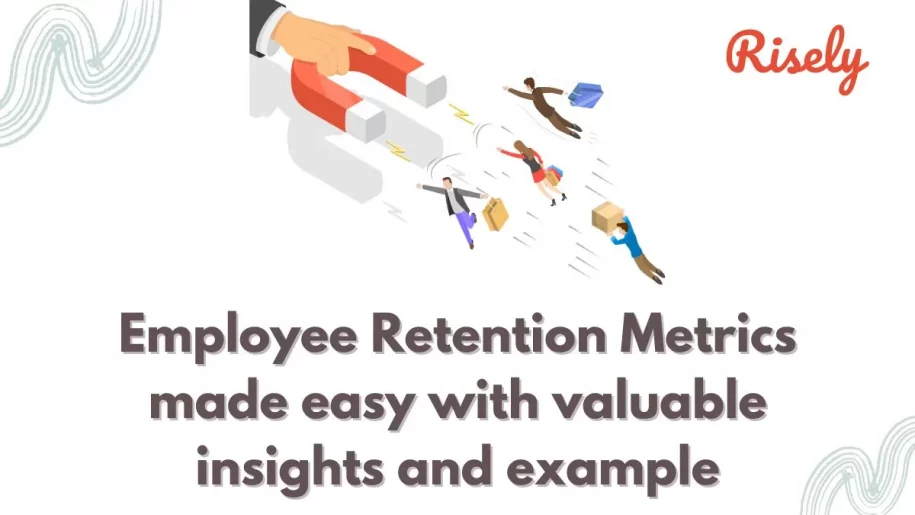Employee Retention Metrics made easy with valuable insights and example
One of the biggest challenges for HR professionals is to retain employees. Retention isn’t just about salaries, bonuses, or promotions. It’s a collective effort that involves factors like employee engagement, satisfaction, and well-being. Measuring employee retention is essential as it helps companies identify improvement areas and take corrective actions accordingly. In this blog, we will discuss everything you need to know about employee retention metrics. We will differentiate between employee turnover and retention, understand the employee retention metrics for measuring employee retention, like retention rate and voluntary/involuntary turnover rate, and learn to use employee retention formula with examples.Getting the basics right
Employee retention refers to an organization’s ability to keep its employees engaged and satisfied with their jobs, resulting in them staying with the company for an extended period. It is a critical aspect of workforce management and can significantly impact an organization’s success. High employee retention rates can increase productivity, lower recruitment costs, and a more stable and experienced workforce. Employee retention metrics are quantitative measurements used to assess and track the rate employees remain with an organization over a specific period. These metrics help HR professionals and business leaders understand their retention efforts’ effectiveness and identify improvement areas.Why measuring Employee Retention is important?
Understanding the importance of measuring employee retention is crucial for organizations. Here are 4 of them to begin with:- Cost Savings: High turnover can be costly for organizations. When employees leave, direct expenses are associated with recruiting, onboarding, and training new hires. Additionally, there can be indirect costs related to decreased productivity, reduced morale among remaining employees, and potential disruptions to workflow. By measuring retention, organizations can identify areas for improvement and implement strategies to reduce turnover, leading to significant cost savings.
- Workforce Stability: A stable workforce is essential for consistent productivity and organizational growth. High turnover rates can disrupt operations and hinder long-term planning. Measuring retention allows organizations to gauge the stability of their workforce and take action to maintain a more consistent and experienced team. This stability can also contribute to a more positive workplace culture.
- Talent Development: Retaining employees often means retaining valuable institutional knowledge and expertise. When experienced employees stay with the organization, they can mentor and develop newer employees, enhancing overall organizational performance. Measuring retention can help identify key individuals or departments with a high retention rate and provide insights into best practices for talent development and succession planning.
- Employee Satisfaction and Engagement: High turnover rates can indicate underlying issues with job satisfaction, workplace culture, or management practices. Organizations can gather feedback and insights into why employees are leaving by measuring retention and conducting exit interviews or employee surveys. This information can be used to make improvements, enhance employee engagement, and create a more positive work environment, which, in turn, can lead to higher retention rates.
Other Interesting Reads
Employee Retention and Turnover
Employee turnover and employee retention are two essential concepts in HR management. Employee turnover refers to the number or percentage of employees who leave an organization voluntarily or involuntarily. On the other hand, employee retention focuses on retaining employees and creating a loyal workforce. Retention strategies aim to reduce voluntary turnover and improve overall retention rates. Understanding the difference between turnover and retention is crucial for managing human resources effectively and addressing challenges related to talent turnover. By differentiating between these two concepts, organizations can develop strategies to foster employee satisfaction, increase employee morale, and ultimately create a more productive and engaged workforce.Voluntary versus Involuntary Turnover
Voluntary turnover is when employees leave the organization due to job dissatisfaction or better opportunities elsewhere. In contrast, involuntary turnover occurs when employees are terminated or laid off by the company, typically due to poor performance, misconduct, or organizational restructuring. Managing voluntary turnover requires a deep understanding of employee needs and concerns and the ability to address them effectively. By identifying the reasons behind both types of turnover, organizations can develop strategies to reduce voluntary turnover and create a more stable and engaged workforce.Employee Retention Metrics
Employee retention metrics are essential for organizations to assess the effectiveness of their strategies in retaining employees. Several metrics can be utilized for this purpose. The employee retention rate measures the percentage of employees who stay with the company over a given period, providing insight into overall retention. Additionally, the voluntary turnover rate calculates the percentage of employees who leave the organization voluntarily. In contrast, the involuntary turnover rate determines the percentage of terminated or laid-off employees.Employee Retention Rate:
- Definition: This is a key employee retention metric that measures the percentage of employees who remain with the organization over a specific period.
- Calculation: To calculate the employee retention rate, you typically use the following formula:
- Employee Retention Rate = ((Number of Employees at the End of the Period – Number of Employees Who Left) / Number of Employees at the Start of the Period) x 100
- Significance: This employee retention metric provides an overall view of an organization’s success at retaining its employees. A higher retention rate indicates that more employees stay with the company, which can be a positive sign of job satisfaction, a healthy work environment, and effective talent management.
Voluntary Turnover Rate:
- Definition: The voluntary turnover rate measures the percentage of employees who leave the organization voluntarily, often to pursue other opportunities or for personal reasons.
- Calculation: To calculate the voluntary turnover rate, use the following formula:
- Voluntary Turnover Rate = ((Number of Employees Who Left Voluntarily / Total Number of Employees) x 100
- Significance: A high voluntary turnover rate may indicate dissatisfaction with the job, work environment, or compensation. Monitoring this employee retention metric can help organizations identify areas for improvement in employee satisfaction and retention strategies.
Involuntary Turnover Rate:
- Definition: The involuntary turnover rate measures the percentage of employees who leave the organization due to reasons beyond their control, such as layoffs, terminations, or workforce reductions.
- Calculation: To calculate the involuntary turnover rate, use the following formula:
- Involuntary Turnover Rate = ((Number of Employees Who Left Involuntarily / Total Number of Employees) x 100
- Significance: A high involuntary turnover rate may indicate workforce planning, performance management, or organizational stability issues. Monitoring this employee retention metric is essential to ensure that involuntary turnover is managed effectively and that administrative decisions are made considering employee well-being.
How to Calculate Employee Retention?
Employee retention is typically calculated using the following employee retention formula: Employee Retention Rate (%) = [(Number of Employees at the Start of the Period – Number of Employees Who Left During the Period) / Number of Employees at the Start of the Period] x 100 Let’s break down the employee retention formula and provide an example: Suppose you want to calculate the employee retention rate for a specific quarter. At the beginning of the quarter, your organization had 500 employees. During the same quarter, 30 employees left the company voluntarily or involuntarily. To calculate the employee retention rate: Employee Retention Rate (%) = [(500 – 30) / 500] x 100 Employee Retention Rate (%) = (470 / 500) x 100 Employee Retention Rate (%) = 94% In this example, the employee retention rate for the quarter is 94%. This means that 94% of the employees with the company at the beginning of the quarter remained with the organization by the end of the quarter, while 6% of the employees left. A high retention rate (closer to 100%) indicates that the organization successfully retains its employees, which can be a positive sign. Conversely, a lower retention rate suggests that the organization may be experiencing higher turnover, which could have various implications, including increased costs and potential issues with job satisfaction or workplace culture. Measuring employee retention regularly, such as on a quarterly or annual basis, and comparing it over time can help organizations track trends and identify areas where retention efforts may need to be improved. Additionally, organizations can use the insights gained from retention rate calculations to develop targeted strategies for enhancing employee engagement and satisfaction, ultimately leading to improved retention rates.Conclusion
In conclusion, measuring employee retention is crucial for building a strong and stable workforce. By understanding the factors contributing to employee turnover and implementing strategies to improve retention, businesses can create a positive work environment that fosters loyalty and commitment. It’s important to differentiate between voluntary and involuntary turnover, as each requires a different approach. Organizations can gain valuable insights into their retention efforts by tracking employee retention metrics such as employee retention rate, voluntary turnover rate & involuntary turnover rate. Remember, a reasonable employee retention rate varies by industry and company but generally falls between 80-90%. Businesses can make informed decisions and take proactive steps to ensure long-term success by effectively measuring and analyzing employee retention. Don’t forget to use the employee retention formula to find the employee retention rate at your workplace!Ace performance reviews with strong feedback skills.
Master the art of constructive feedback by reviewing your skills with a free assessment now.
Other Related Blogs
7 Examples of Employee Relations Issues and How to Handle Them
Good employee relations are essential for a healthy and productive work environment. However, even the best-managed organizations can face employee relations issues from time to time. These issues can range…
Becoming an Effective Employee Relations Manager: 5 Skills You Need
Becoming an Effective Employee Relations Manager: 5 Skills You Need As an Employee Relations Manager, you are crucial in ensuring that employee needs are met and the organization operates smoothly.…
6 Steps To An Effective Employee Engagement Action Plan With Tips & Benefits
6 Steps To An Effective Employee Engagement Action Plan With Tips & Benefits Have you ever noticed how some workplaces buzz with energy and enthusiasm while others feel like they’re…
How Can Managers Build Loyalty In The Workplace?
How Can Managers Build Loyalty In The Workplace? Undoubtedly, employee loyalty is essential for managers and leaders in the workplace. A workforce loyal to their managers and leaders is more…


